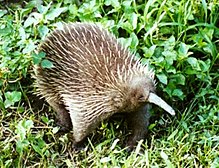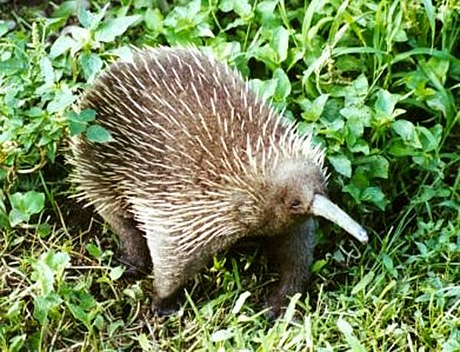The long-beaked echidnas make up one of the two genera (Genus Zaglossus) of echidna. Echidna is a spiny monotreme that lives in New Guinea. There are three living species, and two extinct ones.
| Long-beaked echidnas[1] Temporal range: Miocene to present | |
|---|---|
 | |
| Western long-beaked echidna (Zaglossus bruijni) | |
| Scientific classification | |
| Domain: | Eukaryota |
| Kingdom: | Animalia |
| Phylum: | Chordata |
| Clade: | Synapsida |
| Class: | Mammalia |
| Order: | Monotremata |
| Family: | Tachyglossidae |
| Genus: | Zaglossus Gill, 1877 |
| Type species | |
| Zaglossus bruijni Peters and Doria, 1876 | |
| Species | |
|
Zaglossus attenboroughi | |
Echidnas are one of only two types of living mammals that lay eggs.
Species
Zaglossus attenboroughi
- Habitat: regions of New Guinea at higher elevation than highland forests
- Era: the present
- Status: Endangered
Remarks: Species described from one sample only. May be endangered, or locally extinct. See Sir David's Long-beaked Echidna
Zaglossus bartoni
- Habitat:on the central cordillera between the Paniai Lakes and the Nanneau Range, as well as the Huon Peninsula
- Era: the present
- Status: Endangered
Remarks: see Eastern Long-beaked Echidna
Zaglossus bruijni
- Habitat: highland forests of New Guinea
- Era: the present
- Status: Endangered
Remarks: see Western Long-beaked Echidna
Zaglossus hacketti
- Habitat: Western Australia
- Era: Upper Pleistocene
Remarks: This species is known only from a few bones. At a metre long, it was huge for an echidna and for monotremes in general.
Zaglossus robustus
- Habitat: Tasmania
- Era: Pleistocene
Remarks: This species is known from a fossil skull about 65 cm long.
References
Other websites
Wikiwand in your browser!
Seamless Wikipedia browsing. On steroids.
Every time you click a link to Wikipedia, Wiktionary or Wikiquote in your browser's search results, it will show the modern Wikiwand interface.
Wikiwand extension is a five stars, simple, with minimum permission required to keep your browsing private, safe and transparent.
